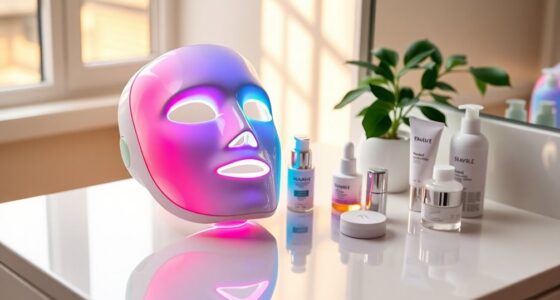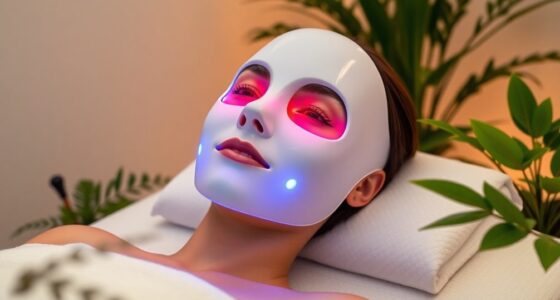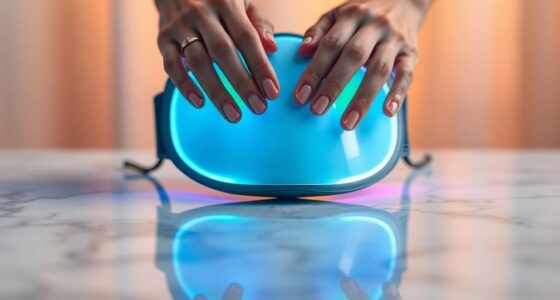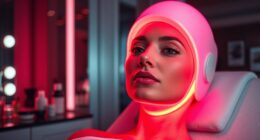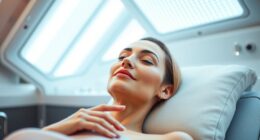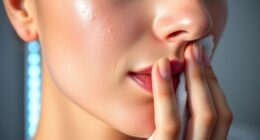LED masks work by emitting specific wavelengths of light that stimulate skin cells. Red light boosts collagen production, reducing wrinkles, while blue light targets acne-causing bacteria. This light therapy enhances blood circulation, delivering nutrients and oxygen to the skin, resulting in improved texture and clarity. For ideal results, consistent use is key. Interested in discovering more about the types of light used and their benefits? There’s plenty more to explore on this illuminating skincare tool!
Key Takeaways
- LED masks use light therapy with specific wavelengths to stimulate biochemical reactions in skin cells for improved skin health.
- Red light (630-660 nm) enhances collagen production and reduces wrinkles, while blue light (405-420 nm) targets acne-causing bacteria.
- Near-infrared light (800-1,400 nm) penetrates deeper, promoting cellular activity and overall skin rejuvenation.
- Regular use, typically five times a week for 3 to 20 minutes, is essential for achieving visible results.
- Consistent application leads to improved skin texture, reduced fine lines, and an overall healthier appearance.
What Are LED Masks?

LED masks are innovative skincare devices designed to enhance your skin health through light therapy. Made from silicone and fitted with tiny bulbs, these masks emit specific wavelengths of light that promote biochemical reactions in your skin cells.
The most commonly used colors are red light and blue light therapy. Red light targets aging concerns by boosting collagen production, giving your skin a youthful appearance. Meanwhile, blue light therapy effectively combats acne thanks to its antibacterial properties.
Unlike traditional sun exposure, these masks don’t emit UV light, eliminating the risk of skin damage. Originally found in dermatological offices, LED masks are now accessible for home use, allowing you to seamlessly incorporate light therapy into your daily skincare routine.
How Do LED Masks Work?

To understand how LED masks work, you need to look at the specific wavelengths of light they emit.
Red light stimulates collagen production, while blue light targets acne-causing bacteria, creating a synergistic effect for your skin.
Light Wavelengths Explained
When it comes to understanding how light wavelengths play an essential role in LED masks, you’ll find that different colors serve distinct purposes for skin health.
Here’s a quick overview:
- Red Light Therapy (630 to 660 nm) boosts collagen production and reduces wrinkles.
- Blue Light Therapy (405 to 420 nm) targets acne-causing bacteria and regulates oil production.
- Near-Infrared Light (800 to 1,400 nm) penetrates deeper layers, stimulating cellular activity and enhancing healing.
The effectiveness of LED masks hinges on the proper penetration of these light wavelengths.
Not all LED lights offer the same therapeutic benefits, so consistent use is vital.
With regular treatments, you can expect visible improvements in your skin concerns, texture, and overall appearance.
Mechanism of Action
While exploring how LED masks function, it’s important to understand that they utilize specific light wavelengths to initiate biochemical reactions in your skin cells. Red light, for example, penetrates deeper layers, stimulating mitochondria to produce ATP, which boosts collagen production and reduces inflammation. This process enhances blood circulation, improving nutrient delivery and oxygenation to your skin.
| Light Color | Benefits | Wavelength (nm) |
|---|---|---|
| Red | Boosts collagen production | 630-660 |
| Blue | Kills acne-causing bacteria | 405-420 |
| Green | Reduces pigmentation | 520-550 |
| Yellow | Improves skin texture | 590-600 |
Regular LED therapy is essential for visible results, as cumulative effects promote sustained skin rejuvenation.
Types of Light Emitted by LED Masks

When you use an LED mask, you’ll encounter different types of light, each offering unique benefits for your skin.
Red light therapy boosts collagen production, while blue light therapy targets acne by eliminating bacteria.
Near-infrared light penetrates deeply, enhancing healing processes and cellular metabolism, making it a powerful tool for skin rejuvenation.
Red Light Therapy
Red light therapy, a key feature of many LED masks, operates within a wavelength range of 630 to 660 nanometers. This therapy penetrates your skin effectively, stimulating collagen production and reducing wrinkles.
It enhances microcirculation, improving blood flow and aiding nutrient delivery for overall skin health.
Benefits of red light therapy include:
- Stimulating collagen for firmer skin
- Reducing inflammation to calm various skin conditions
- Promoting healing and reducing visible signs of aging
Regular use can lead to cumulative effects, allowing you to notice improvements in texture and firmness.
Plus, unlike other light types, red light doesn’t cause heat damage, making it a safe choice for all skin types in your skin care routine.
Blue Light Therapy
Blue light therapy, emitted by LED masks at wavelengths between 405 and 420 nanometers, effectively targets acne-causing bacteria like Propionibacterium acnes.
By penetrating the skin, this light therapy reduces inflammation and regulates oil production, helping to prevent future breakouts.
Consistent use of blue light therapy can lead to a significant reduction in acne lesions and an overall improvement in skin texture.
Unlike UV light, blue light doesn’t damage the skin or cause tanning, making it a safer treatment option.
Many LED masks combine blue light with other wavelengths, such as red light, to enhance overall skin health by addressing multiple concerns simultaneously.
Embracing blue light therapy can be a game-changer in your skincare routine.
Near-Infrared Light
While blue light therapy effectively targets acne, near-infrared (NIR) light offers a different set of benefits for your skin. Emitting wavelengths from 800 to 1,400 nanometers, NIR light penetrates deeper layers, stimulating the production of collagen and elastin. This leads to enhanced skin elasticity and reduced signs of aging.
Here are some key benefits of NIR light:
- Promotes skin rejuvenation through improved blood circulation
- Aids in nutrient delivery for healthier skin cells
- Provides non-thermal stimulation, avoiding heat damage
With regular use of LED masks featuring near-infrared light, you can expect noticeable improvements in skin texture and firmness over time.
Embrace the power of NIR light for a more youthful, radiant complexion!
Benefits of Using LED Masks

Using LED masks can considerably enhance your skincare routine, as they harness specific wavelengths of light to address various skin concerns.
The red light therapy in these masks stimulates collagen production, boosting elastin synthesis to improve skin texture and firmness. You’ll notice a reduction in fine lines and wrinkles, giving your skin a more youthful appearance over time.
If acne is a concern, blue light therapy effectively targets acne-causing bacteria, helping reduce breakouts and prevent future flare-ups by regulating oil production.
Plus, the non-invasive nature of LED masks offers a convenient at-home treatment option with minimal downtime, making them suitable for all skin types without the need for harsh chemicals or invasive procedures.
Enjoy clearer, smoother skin!
Recommended Usage and Best Practices

To achieve the best results with LED masks, consistency is key, so aim to use your mask five times a week.
Sessions should last between 3 to 20 minutes, depending on your device’s guidelines. Before you start, make sure your face is clean and dry to maximize light absorption.
After each treatment, apply hydrating skincare products to enhance moisture retention and support skin recovery.
Here are some best practices to keep in mind:
- Avoid using LED masks with topical retinoids to prevent irritation.
- Document your skin’s progress with photos over at least one month to track improvements.
- Adjust your routine based on your skin’s response and needs.
Following these recommended usage tips will help you maximize your LED mask benefits.
Risks and Considerations

Though LED masks offer numerous benefits, it’s important to be aware of potential risks and considerations before incorporating them into your skincare routine.
While they’re generally safe to use for most, individuals with light sensitivity should exercise caution based on their skin type. Always wear eye protection during sessions, especially with blue light therapy, to prevent potential damage.
Be mindful of side effects like irritation, redness, or increased inflammation if you overuse the device or apply it incorrectly. If you have existing skin conditions or concerns, a consultation with a dermatologist is advisable to tailor your approach.
Following the manufacturer’s instructions closely minimizes risks and guarantees effective treatment, helping you achieve the best results without complications.
Comparing Professional LED Treatments to At-Home Devices

Understanding the differences between professional LED treatments and at-home devices can help you make an informed decision about your skincare routine.
- Professional treatments offer stronger wavelengths and greater intensity, leading to enhanced skin benefits.
- At-home devices are more affordable, ranging from under $50 to nearly $2,000, but results can vary.
- Regular use of LED light therapy at home is essential for visible improvements, though these may be subtler compared to in-office sessions.
While professional treatments may use a broader spectrum, including red and near-infrared light, at-home devices can still provide effective results if used consistently.
Verify any device you choose is FDA cleared for safety and efficacy.
User Experiences and Testimonials

How do users feel about their experiences with LED masks? Many rave about the results, particularly regarding improved skin texture and a noticeable glow. Regular usage, typically five times a week, is emphasized for ideal benefits. Users appreciate the soothing experience of treatments, often multitasking by watching TV while their skin gets pampered.
Here’s a glimpse into user experiences:
| User Experience | Results | Frequency |
|---|---|---|
| Reduced fine lines | Softer, smoother skin | 5 times a week |
| Relief from redness | Enhanced overall glow | At least 1-month testing |
| Comfortable fit | Improved skin resilience | Daily routine |
| Soothing post-flight use | Less tightness after travel | Weekly maintenance |
| Enjoyable self-care time | Visible rejuvenation | Consistent application |
These testimonials highlight how LED masks can transform your skincare routine!
Future Trends in LED Mask Technology

As users continue to share their positive experiences with LED masks, the future of this technology looks promising. Advancements in LED devices are on the horizon, enhancing both user experience and effectiveness in skincare routines.
Here’s what you can expect:
- Smart technology integration for personalized treatment plans
- Optimization of wavelengths and dosages for targeted light therapy uses
- Expansion beyond dermatology, including pain management applications
With an increasing consumer demand for non-invasive skincare treatments, future trends suggest that these FDA-approved masks will become even more versatile.
As research progresses, you’ll likely find LED masks becoming essential tools in your skincare arsenal, offering tailored and effective solutions for various skin concerns.
Frequently Asked Questions
Does a LED Face Mask Really Work?
You might wonder if a LED face mask really works.
Many users report subtle improvements in skin texture and wrinkles after regular use, but results can vary. Factors like device quality, usage frequency, and your individual skin type play significant roles.
While generally safe, be cautious of potential irritation. It’s crucial to follow manufacturer guidelines and consider your skin’s sensitivity to get the best results from your treatment.
Always check for FDA clearance too.
What Are the Disadvantages of a LED Mask?
When considering LED masks, you should be aware of some disadvantages.
They can cause skin irritation or redness, especially if you overuse them or don’t follow the guidelines. You might find that their effectiveness is less than in-office treatments, leading to subtle rather than dramatic results.
Additionally, prolonged exposure to certain light types could damage your skin. Individual outcomes vary widely, so what works for someone else mightn’t work for you.
Is It Okay to Use a LED Face Mask Every Day?
Isn’t it tempting to think that daily pampering could transform your skin? Yes, you can use an LED face mask every day, but it’s essential to pay attention to your skin’s response.
Most masks are safe for daily use, enhancing collagen and hydration. Just stick to the manufacturer’s guidelines and watch for irritation.
If your skin’s happy, keep it up for at least a month to see those desired results!
How to Know if a LED Mask Is Working?
To know if your LED mask is working, track any changes in your skin after consistent use for at least a month.
You should look for smoother texture, fewer fine lines, and a reduction in acne breakouts. Taking before-and-after photos can help you visually compare improvements.
Also, pay attention to hydration and firmness, as these can indicate enhanced collagen production.
Finally, consider consulting a dermatologist for professional feedback on your progress.
Conclusion
To sum up, LED masks can be a game-changer for your skincare routine. Did you know that studies show 80% of users report visible improvements in their skin after consistent use? By choosing the right light type and following recommended practices, you can enhance your skin’s appearance while enjoying a spa-like experience at home. As technology advances, these masks are likely to become even more effective, making them a worthy investment for anyone seeking healthier skin.



